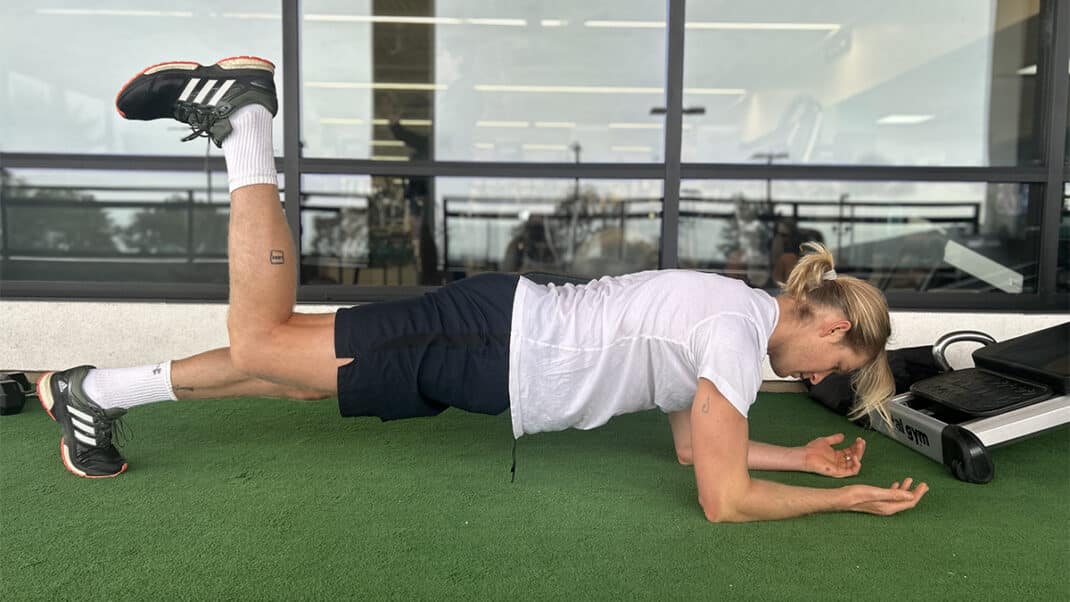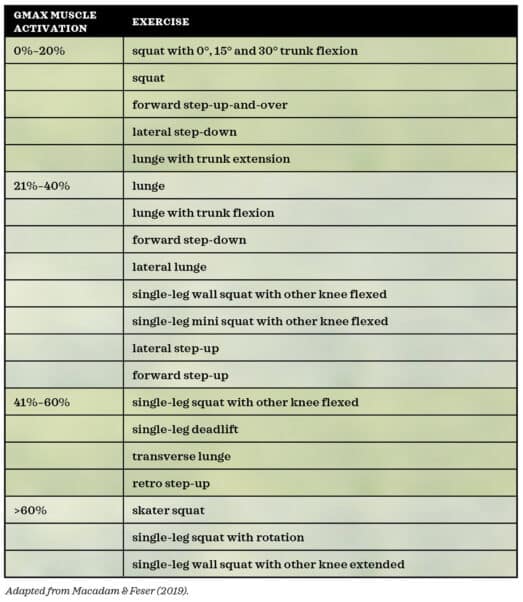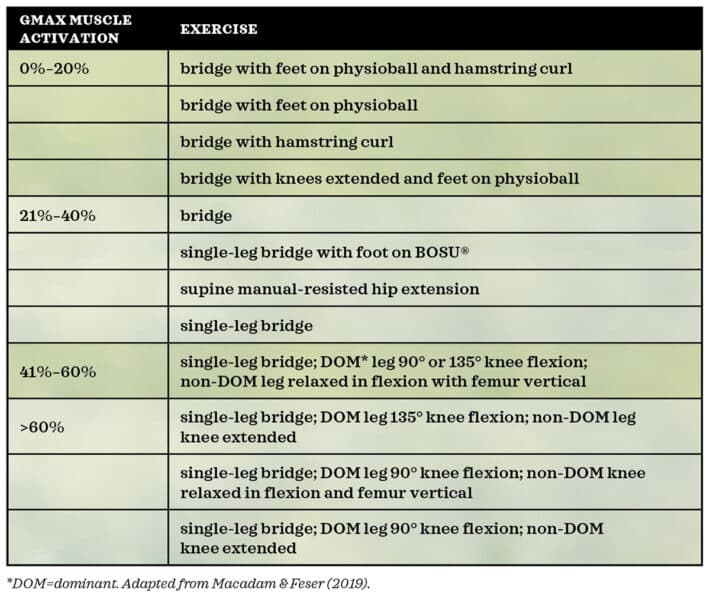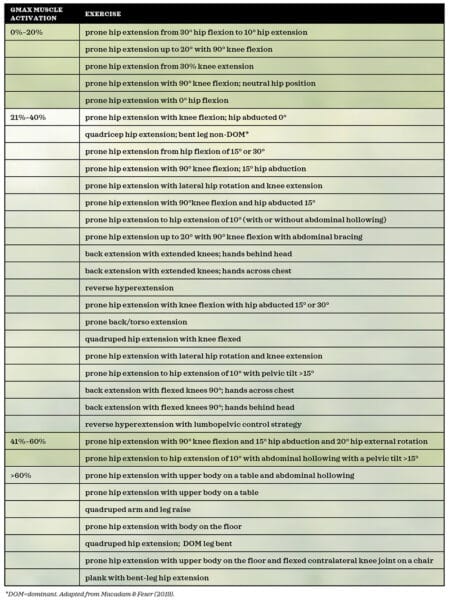Glutes, Glutes and More Glutes!
Research-based protocols for creative and effective training.
| Earn 1 CEC - Take Quiz

The gluteus maximus (Gmax) is the largest muscle in the human body (Bartlett et al. 2014; Wilson et al. 2005)—and popular, too! Many clients are quite fixated on training and developing their glutes.
This article discusses the role of the Gmax in normal function, defines its architecture, reports research on the exercises that emphasize the Gmax muscle activity, presents several training techniques for the Gmax and explores the controversy of deep squats. Think of it as your glutes toolkit for effective, fun and creative programming.
The Role of Glutes in Normal Functioning
Due to its anatomical attachments, the Gmax is primarily involved in hip extension and lateral rotation. Additionally, the upper Gmax fibers help to abduct the thigh (move it away from midline of body), while the lower fibers assist in adducting the thigh (moving it toward midline of body). Here’s what that means in terms of sports and everyday movement.
Locomotion and Propulsion
The Gmax is actively involved in several bodily actions, such as running, throwing and squatting. During locomotion, the Gmax provides weight support and propulsion. In steady-paced walking, the involvement of the Gmax is modest, but during running, sprinting, incline walking and stair walking, the Gmax becomes much more engaged (Bartlett et al. 2014).
Hip Extension
Hip extension is a major joint action in several sporting actions, such as running and jumping, and in daily activities, including stepping, walking and lifting. This movement primarily involves the Gmax, hamstrings (long head of biceps femoris, semimembranosus and semitendinosus) and the posterior head of the adductor magnus (Macadam & Feser 2019). The hip extensor musculature can produce more torque than any other muscle group involved in hip movement.
This single-joint muscle allows for increased force production to maintain an upright position needed for walking, running and hopping. With walking gait, the Gmax contributes to hip extension while controlling the rate of hip flexion (Wilson et al. 2005).
Joint Stabilization
The Gmax also provides stability for the sacroiliac joint, as well as strength for lifting and gait control (Wilson et al. 2005). There is little movement at the sacroiliac joint, thus enhancing its primary function of load transfer from the trunk to the legs.
During lifting movements, the Gmax plays a meaningful role in stabilizing the pelvis while extending the hips. Wilson et al. summarize research that suggests contracting the Gmax during the early phase of a lift enables an effective and safe movement to occur, while also stabilizing the pelvis.
It is important to note that an imbalance in strength within the glutes (or a weakness in one side of the muscle) has been associated with lower-extremity injuries, including anterior cruciate ligament sprains, patellofemoral pain syndrome and chronic ankle instability.
See also: Wake Up Your Glutes!
Glute Muscle Architecture and Composition
Muscle architecture is often referred to as the organization of muscle fibers relative to the tendon, which is the axis of force generation. The organization of muscle fibers within a muscle is highly associated with the function of that muscle. The metabolic properties, fiber type distribution and muscle mass influence the contractile properties of the muscle (Ward, Winters & Blemker 2010). Additionally, the force-generating capacity of a muscle is also influenced by the velocity of movement. As velocity increases, force decreases.
Regarding muscle composition, or the makeup of muscles, skeletal muscles are largely composed of sarcomeres, referred to as the functional unit of muscle. Sarcomeres pack together end-to-end (in a series) as well as side by side (parallel). Packing sarcomeres in their parallel formation leads to greater force production because more sarcomeres are acting on the tendon. When looking at the physiological cross-sectional area (PCSA) of a muscle—or a cross-section of the muscle perpendicular to its fibers—muscles with large PCSAs and shorter fiber lengths can generate large forces.
Uniquely, the gluteus maximus has a large PCSA with longer muscle fibers, suggesting that it can generate large forces over a wide range of lengths (Ward, Winters & Blemker 2010).
Exercises That Target the Glutes

There are a variety of hip extension exercises for training the Gmax for rehabilitation programming, recreational goals and athletic performance. Note that as clients alter their body position during a hip extension exercise, there is likely to be a change in the amount of body mass being moved and, thus, the muscle mass activation (Macadam & Feser 2019).
To determine the muscle activation of Gmax exercises, Macadam & Feser conducted a comprehensive systematic review that included 39 studies that describe the electromyographic (EMG) excitation of the Gmax during exercises that incorporate hip extension. Macadam & Feser explain that, historically, exercises have been examined through EMG analysis with the overall consensus (after analysis from scientists) that exercises producing higher levels of muscular excitation are associated with greater long-term hypertrophy and strength gains.
From their review, Macadam & Feser were able to categorize the muscle excitation in the following ways: A range of 0%–20% is considered low muscle activation; 21%–40% is moderate muscle activation; 41%–60% is high muscle activation; and >60% is very high muscle activation. This organization plan, which has been adapted and presented in “Lunge, Squat & Deadlift Exercises,” “Bridge Exercises,” and “Prone Position Hip Extension Exercises,” all below, helps fit pros select exercises that match the abilities of their clients while also allowing for specific targeting of the exercises for endurance, strength and/or hypertrophy.
Unique Gmax Training Research Findings
The recent systematic review by Macadam & Feser provides some unique findings with useful takeaway values for fitness pros.
Initially, note that squat exercises—due to their greater base of stability—are quite satisfactory for entry-level clients. Note that for any vertical-oriented exercise (e.g., any squat), unilateral versions result in more Gmax muscle activation than do bilateral versions. Macadam & Feser propose that clients should master the correct techniques of bilateral exercises before progressing to unilateral versions.
All variations of the single-leg squat elicit very high muscle activation. The single-leg squat also showed a difference in muscle activation between males and females, with females displaying greater muscle activation than males in three studies. (Females also displayed greater muscle activation on the forward step-down, lateral step-down and single-leg wall slide.)
The lunge resulted in a small-to-moderate level of Gmax muscle activation. Macadam & Feser suggest that the lunge (forward and lateral) can be an early progressive exercise leading to forward and lateral step-down exercises. Step height is always an effective modifying factor to increase or decrease the stability challenges of a Gmax exercise.
The single-leg bridge was also found to elicit a higher range of Gmax EMG excitation as compared with the two-legged bridge, most likely due to the greater demands required to stabilize the lower body with one leg off the ground. Somewhat surprisingly, the research showed that levels of muscle activity were lower than expected when bridging on a physioball and/or when participants were asked to perform a hamstring curl movement from a bridge position on the ball.
Importantly, when verbal and tactile cues were added to the instructions for the client, there was a meaningful increase in Gmax muscle activation. Fit pros should regularly provide verbal cuing to clients during Gmax exercises, having them laser-focus on the target muscle being trained.
Another highlight was the increase in Gmax muscle activation when participants did abdominal bracing or abdominal hollowing with their exercises. Thus, including core focus with Gmax exercise training is a worthy strategy for fitness pros to consider with their clients.
Finally, it was shown that hip extension exercises performed in greater degrees of hip flexion, hip abduction or hip external rotation resulted in greater Gmax muscle activation. This validates that range-of-motion increases with a Gmax exercise directly influence the level of muscle activation of the Gmax.
See also: The 3D Booty: Training the Glutes for Form and Function
The Best Ways to Train the Glutes

A popular search engine and the phrase, “what are the best ways to train the gluteus maximus” resulted in 1.64 million hits. No doubt this is a common social media question that will continue to increase in popularity. Research shows, however, that periodization training is a highly effective training strategy for the human body musculature.
A Refresher on Periodization Training
Periodization is defined as a planned, cyclical manipulation (i.e., the program repeats) of resistance training variables to attain peak performances (typically for athletes) at specific times of the year (Evans 2019). Variables manipulated include sets, repetitions, exercise selection, intensity (e.g., load), frequency of sessions, rest between sets, and repetition tempo (i.e., timing of the eccentric, hold and concentric phases of the lift).
Periodized resistance training plans are comprised of several cycles, which include macrocycles (6–12 months), mesocycles (~1 month) and microcycles (~1 week) (Evans 2019; Issurin 2010).
The length of each training cycle varies depending on the goals of each client or athlete. Positively, a major purpose of periodization is to provide structured variability to combat a physical performance plateau or decline. Many clients working the Gmax seek to gain muscle size and improve its shape with their training sessions. This indicates that fit pros should consider a hypertrophy-based periodization approach. Here are four periodization plans you can utilize with clients.
Linear Periodization
Linear periodization involves an exercise strategy that starts with high volume and low intensity and then progresses to low volume and high intensity (Grgic et al. 2017). With this model, clients will gradually increase the intensity of the load as the program progresses while simultaneously decreasing the volume. Theoretically, the initial high-volume phase is emphasizing hypertrophic adaptations, and the later high-intensity period challenges the neural mechanisms in the body. Although linear periodization program designs vary between personal trainers and coaches, it’s common to make changes to volume and intensity every 4 weeks (Grgic et al. 2017).
Block Periodization
Block periodization involves training cycles made up of several mesocycles, each with a concentrated training stimulus (Bartolomei et al. 2014). The blocks of training are arranged so that one block prepares the client for the next, and those blocks are arranged, for sport applications, into three categories: accumulation, transformation and realization (Issurin 2010).
Issurin reports that, conventionally, the accumulation block focuses primarily on general aerobic endurance, basic muscle strength and foundational movement techniques. Next, in the transformation block, the client performs specialized muscle conditioning and proper sport-specific techniques. Last, the realization block is often considered a pre-competition training phase because it focuses on attaining maximal speed and performance. Each block lasts 2–6 weeks based on the duration of the program and specific goals for the client.
Undulating Periodization
Undulating periodization (UP) involves frequent alterations of volume and intensity within a training program, and these alterations are often done weekly (WUP) and/or daily (DUP) (Evans 2019).
During a WUP program, clients cycle through weeks of light-, moderate- and high-
intensity training, whereas during a DUP program, these intensities will vary from day to day. Practically speaking, with DUP, a client may do a hypertrophy, strength and power workout within the same week. Evans summarizes research indicating that UP programs are likely the best choice for developing strength in resistance training programs.
McNamara & Stearne (2010) submit that another advantage of undulating programs is that they help to prevent overtraining and mental boredom, while also being easily adapted to a client’s schedule. Frequent changes of volume and intensity in undulating programs may induce larger neural adaptations while simultaneously counteracting fatigue.
Flexible Periodization
As every fit pro can confirm, life brings unexpected twists that will cause clients to have undue stress that can interfere with their ability to perform at their optimal level. Even a poor night of sleep or a less-than-ideal pre-exercise meal (or lack of a meal) may leave clients feeling fatigued and unmotivated, even before the training session begins. For situations like these, it may be best to modify the workout of the day to accommodate the client’s energy level and mood by employing flexible undulating periodization.
Flexible undulating periodization is a transient strategy to modify a periodization program to adapt to a client’s immediate health, nutrition or energy level circumstance. Employ flexible undulating periodization by simply assessing the present state of the client immediately before their training session and adjusting the workout accordingly.
Ultimately, a flexible periodization approach accounts for daily fluctuations in fatigue and psychological readiness of a client. It may also increase exercise adherence by providing clients with autonomy and the freedom to help direct their training sessions through changes in physiological status and mental demeanor.
See also: Periodization for Maximizing Hypertrophy
Final Thoughts on Glutes
Fortunately, research has provided numerous exercise variations to keep your Gmax training programs creative and highly stimulating (mentally and physically!). Over the long run, the research indicates that when the physiological training stress is regularly changed (e.g., with periodization models), improvement in strength or hypertrophy of the glutes will continue. Enjoy using all the highly researched periodization models highlighted in this article, and keep adding variety to your clients’ Gmax workouts. Glutes, glutes and more glutes . . . You’ve got this!
Lunge, Squat and Deadlight Exercises
Bridge Exercises
Prone Position Hip Extension Exercises
Are Deep Squats Safe and Effective?
The potential benefits and risks of injury to the knee when performing the closed-kinetic-chain deep squat exercise is of great debate with personal trainers, coaches and rehabilitation specialists. This specific question was debated in a point-counterpoint column in the Journal of Strength and Conditioning by Schoenfeld & Williams (2012). Highlights of this publication are summarized in the next few paragraphs.
The Beginning of the Squat Controversy!
Before diving into the Schoenfeld & William’s pro-and-con analysis, it’s important to look at the historical roots of squat safety, starting with Karl Klein, MD, in 1961. Klein’s research investigated the ligaments of participants who did deep squats versus those who did no squats. It should be noted that Klein used a measuring device that he developed for his research. Klein’s conclusion was that deep squats (as done in weight training and general conditioning activities) should be discouraged because of the potential debilitative effect on the ligamental structures of the knees. Klein suggested that deep knee bends, duck-walking exercises and squat jumping could weaken the ligamental structure of the knee. His squatting recommendation was that the thighs should descend no lower than parallel to the ground. Notably, a 1962 article in Sports Illustrated brought attention, fame and support to Klein for this research about the deleterious effects of deep squatting (Underwood 1962). Underwood also explained that, largely due to Klein’s research, the American Medical Association endorsed (at that time) Klein’s research, stating that the AMA generally disapproved of deep knee exercises (due to danger to the medial cartilage of the knee).
Deep Squatting: The Pros
In reviewing studies that followed Klein’s research, Schoenfeld determined that the body of evidence does not support the assertions that deep squats are detrimental to knee-joint stability. Schoenfeld continues, stating that the potential for ligamentous injury would seem to be reduced rather than increased in the deepest portions of the squat. What’s more, a cause-effect relationship between deep squats and the injuries to these structures has not been established in the literature. Schoenfeld concludes that since deep squatting confers a number of important benefits—including improved functional capacity, greater muscle activation, greater muscle development and better athletic performance—there is no reason to avoid this exercise, provided that no medical contraindications exist.
Deep Squatting: The Cons
In the debate about doing deep squats, Williams highlights that few sports require deep squatting and, as such, it is not a routine motion for others to perform. She cites research suggesting that compressive force within the patellofemoral joint seems to be a critical concern. Williams elucidates that high patellofemoral compressive forces can stress the articular cartilage on the undersurface of the patella, which can lead to chondromalacia (i.e., breakdown of the cartilage on the underside of the kneecap), leading to osteoarthritic changes. She thoughtfully concludes by suggesting that trainers should consider what is functional for each individual client—and the sport or activity they participate in—and let this dictate whether deep squatting is warranted.
Add Variety to Gmax Resistance Training
- Vary the intensity. It has been shown that light- (20–30 RM), moderate- (8–10 RM), and high-intensity (2–4 RM) training effectively triggers hypertrophy adaptations (Schoenfeld et al. 2016), empowering you to use a range of loading zones to add variety and keep your clients engaged.
- De-load and/or overreach. For a stimulus change, you may periodically implement microcycles of de-loading, defined as a brief but significant reduction in volume and/or intensity, and/or overreaching, characterized as a concise but significant increase in volume and/or intensity (Turner 2011).
- Change the frequency. Targeting the Gmax 2 days a week is an optimal plan for hypertrophy. However, increasing frequency to 3 days a week is a viable strategy to perform for a periodic cycle (or block) to incite a training overload for a client.
- Try reciprocal supersets. Select exercises that target opposite action muscle groups (e.g., hip abductors and adductors; hip extensors and flexors), and have the client perform these exercises in succession before taking a rest interval. Use this style of training to decrease training time and deliver a stronger metabolic stress to the muscles.
- Perform drop sets. Have the client complete a set of 8–12 reps to fatigue, reduce the load by 10%–20%, and immediately perform as many reps as possible until near failure. Reduce the load by 10%–20% again, and have them complete a third set to near fatigue.
- Partial range of motion. Partial-ROM training, also known as “partials,” focuses on training the middle range of motion of an exercise. It is thought to elicit significant muscular tension by allowing the exerciser to perform resistance training at a higher load compared to lifting with the full range of motion. Here are four partial-range-of-motion ideas from “The Ultimate Guide to Resistance Training Techniques,” from IDEA Fitness Journal (Mang, Ducharme & Kravitz 2022):
-
- split squat—the client descends to full depth and performs half-reps to failure from full depth to half depth
- single-leg squat—from the starting position, the client performs half-reps to failure by only descending to half depth for each rep
- wall squat—the client performs full and half reps where each full-depth exercise is followed by a half-depth exercise until fatigue occurs
- squat—the client performs a sequence of partial reps at different depths by descending to ¼, ½, 3/4 and full depth until fatigue occurs.
References
Bartlett, J.L., et al. 2014. Activity and functions of the human gluteal muscles in walking, running, sprinting, and climbing. American Journal of Physical Anthropology, 153, 124–31.
Bartolomei, S., et al. 2014. A comparison of traditional and block periodized strength training programs in trained athletes. Journal of Strength and Conditioning Research, 28 (4), 990–97.
Evans, J.W. 2019. Periodized resistance training for enhancing skeletal muscle hypertrophy and strength. Frontiers in Physiology, 10 (13), 1–7.
Grgic, J., et al. 2017. Effects of linear and daily undulating periodized resistance training programs on measure of muscle hypertrophy: A systematic review and meta-analysis. PeerJ, doi:10.7717/peerj.3695.
Issurin, V.B. 2010. New horizons for the methodology and physiology of training periodization. Sports Medicine, 40 (3), 189–206.
Klein, K.K. 1961 The deep squat exercise as utilized in weight training for athletes and its effects on the ligaments of the knee. Journal of the Association for Physical and Mental Rehabilitation, 150 (1), 6–11.
Macadam, P., & Feser, E.H. 2019. Examination of gluteus maximus electromyographic excitation associated with dynamic hip extension during body weight exercise: A systematic review. The International Journal of Sports Physical Therapy, 14 (1), 14–31.
Mang, Ducharme & Kravitz 2022. The ultimate guide to resistance training techniques. IDEA Fitness Journal. Accessed Dec. 1, 2022: ideafit.com/personal-training/the-ultimate-guide-to-resistance-training-techniques.
McNamara, J.M., & Stearne, D.J. 2010. Flexible nonlinear periodization in a beginner college weight training class. Journal of Strength and Conditioning Research, 24 (8), 2012–17.
Schoenfeld, B., & Williams, M. 2012. Are deep squats a safe and viable exercise? Strength and Conditioning Journal, 34 (2).
Schoenfeld, B.J., et al. 2016. Effects of varied versus constant loading zones on muscular adaptations in trained men. International Journal of Sports Medicine, doi:10.1055/s-0.1055/s-0035-1569369.
Underwood, J. 1962. The knee is not for bending. Sports Illustrated. Accessed Nov. 29, 2022: vault.si.com/vault/1962/03/12/the-knee-is-not-for-bending.
Ward, S.R., Winters, T.M., & Blemker, S.S. 2010. The architectural design of the gluteal muscle group: Implications for movement and rehabilitation. Journal of Orthopaedic & Sports Physical Therapy, 40 (2), 95–102.
Wilson, J., et al. 2005. A structured review of the role of gluteus maximus in rehabilitation. New Zealand Journal of Physiotherapy, 33 (3), 95–100.
Len Kravitz, PhD
Len Kravitz, PhD is a professor and program coordinator of exercise science at the University of New Mexico where he recently received the Presidential Award of Distinction and the Outstanding Teacher of the Year award. In addition to being a 2016 inductee into the National Fitness Hall of Fame, Dr. Kravitz was awarded the Fitness Educator of the Year by the American Council on Exercise. Just recently, ACSM honored him with writing the 'Paper of the Year' for the ACSM Health and Fitness Journal.






